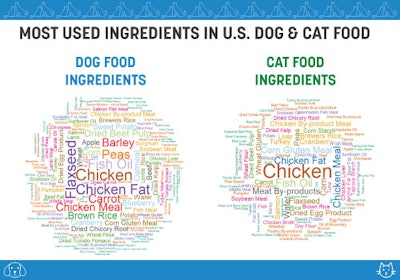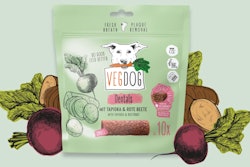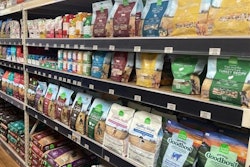
In late 2024, the Institute for Feed Education and Research, the American Feed Industry Association, the North American Renderers Association, and the Pet Food Institute collaborated to update a 2019 report assessing dog and cat food ingredients, sales volumes, economic impact, and ingredient circularity in the U.S. The updated 2025 Pet Food Production and Ingredient Analysis report draws from a study analyzing NielsenIQ data on in-store and online pet food sales, combined with an analysis of product nutrient profiles.
The newly released report estimates that dog and cat food sales reached $51.7 billion in 2024, with 9.8 million tons of pet food containing more than 600 plant- and animal-based ingredients. Chicken and chicken-based ingredients were the most commonly used by weight, while marine ingredients, such as salmon and cod, ranked highest in value.
Since the last report analyzing 2019 data, demand for premium ingredients has surged, with marine ingredients increasing by 95% and meat and poultry ingredients by 34%. Not all categories saw growth, however, as water usage in pet food formulas declined by 22%, and animal protein meals and fats decreased by 12%.
Lara Moody, executive director of IFEEDER, will present the report's updated results during Petfood Forum in Kansas City on April 29 at 3:10 p.m. Click here for more information.
Pet food producers drive economic value across the supply chain
Beyond ingredient trends, the report underscores the pet food industry’s vast economic impact, particularly across 43 U.S. states. In 2024, pet food manufacturers purchased $13.2 billion in farm products, fueling additional economic activity throughout the supply chain.
Farmers supplying these ingredients relied on $9.8 billion in materials and services from their suppliers, who in turn purchased $7.6 billion in equipment, labor, and services from other industries. Among the states leading farm purchases for pet food ingredients, Missouri topped the list at $1.05 billion, followed by Kansas ($1 billion), Pennsylvania ($800 million), Iowa ($603 million), and California ($601 million).
44% of pet food ingredients are upcycled
A new focus of the 2025 report is the use of upcycled ingredients in pet food. In 2024, manufacturers incorporated over 3 million tons of upcycled ingredients into dog food and more than 1 million tons into cat food.
By utilizing nutritious ingredients that might otherwise go to waste—such as organs, bones, and other non-consumed animal parts, along with coproducts from the human food industry—pet food producers are meeting pets' nutritional needs while contributing to a more responsible and efficient supply chain.


















